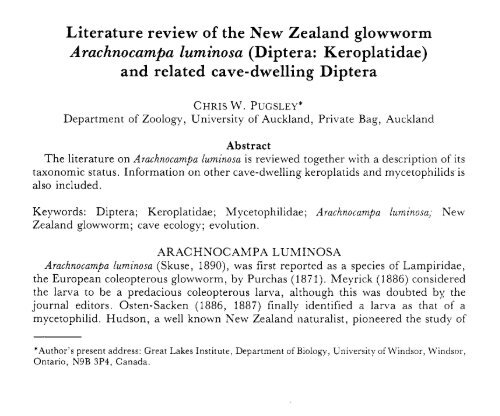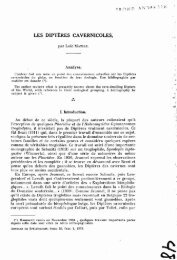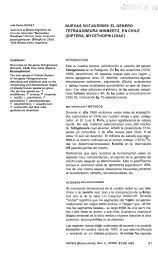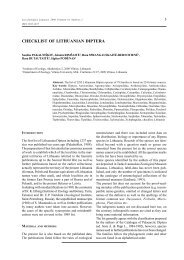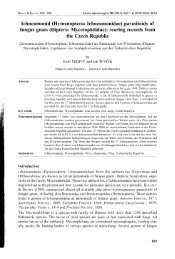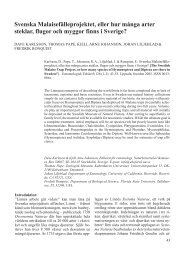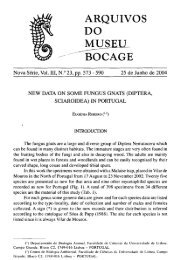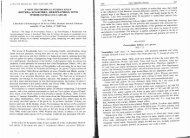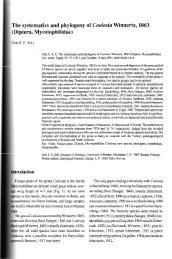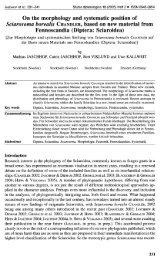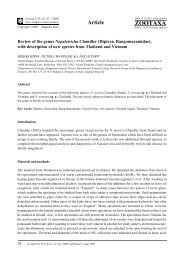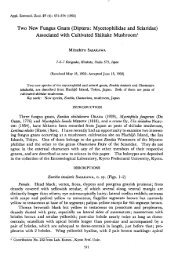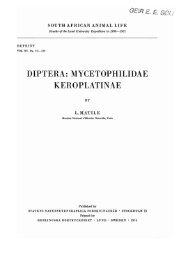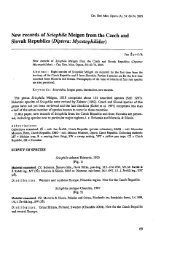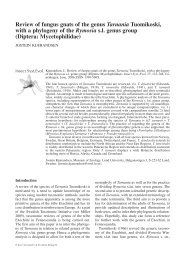Literature review of the New Zealand glowworm Arachnocampa ...
Literature review of the New Zealand glowworm Arachnocampa ...
Literature review of the New Zealand glowworm Arachnocampa ...
You also want an ePaper? Increase the reach of your titles
YUMPU automatically turns print PDFs into web optimized ePapers that Google loves.
<strong>Literature</strong> <strong>review</strong> <strong>of</strong> <strong>the</strong> <strong>New</strong> <strong>Zealand</strong> <strong>glowworm</strong><br />
<strong>Arachnocampa</strong> luminosa (Diptera: Keroplatidae)<br />
and related cave-dwelling Diptera<br />
CHRIS W. PUGSLEY*<br />
Department <strong>of</strong> Zoology, University <strong>of</strong> Auckland, Private Bag, Auckland<br />
Abstract<br />
The literature on <strong>Arachnocampa</strong> luminosa is <strong>review</strong>ed toge<strong>the</strong>r with a description <strong>of</strong> its<br />
taxonomic status. Information on o<strong>the</strong>r cave-dwelling keroplatids and mycetophilids is<br />
also included.<br />
Keywords: Diptera; Keroplatidae; Mycetophilidae; <strong>Arachnocampa</strong> luminosa; <strong>New</strong><br />
<strong>Zealand</strong> <strong>glowworm</strong>; cave ecology; evolution.<br />
ARACHNOCAMPA LUMINOSA<br />
<strong>Arachnocampa</strong> lurninosa (Skuse, 1890), was first reported as a species <strong>of</strong> Lampiridae,<br />
<strong>the</strong> European coleopterous <strong>glowworm</strong>, by Purchas (1871). Meyrick (1886) considered<br />
<strong>the</strong> larva to be a predacious coleopterous larva, although this was doubted by <strong>the</strong><br />
journal editors. Osten-Sacken (1886, 1887) finally identified a larva as that <strong>of</strong> a<br />
mycetophilid. Hudson, a well known <strong>New</strong> <strong>Zealand</strong> naturalist, pioneered <strong>the</strong> study <strong>of</strong><br />
'Author's present address: Great Lakes Institute, Department <strong>of</strong> Biology, University <strong>of</strong> Windsor, Windsor,<br />
Ontario, N9B 3P4, Canada.
420 <strong>New</strong> <strong>Zealand</strong> Entomologist, 1983, Vol. 7, No. 4<br />
A. luminosa in a series <strong>of</strong> publications, describing his observations on <strong>the</strong> habits and life<br />
cycle (Hudson 1886, 1887, 1890, 1892a, 189215, 1926~1, 192613, 1928, 1950). Norris<br />
(1894) added fur<strong>the</strong>r details.<br />
Marshall (1892) described a new species <strong>of</strong> Belytidae reported by Hudson (1892a,<br />
1892b) as being parasitic on <strong>glowworm</strong> pupae in <strong>the</strong> botanical gardens, Wellington. It<br />
has not been reported as a <strong>glowworm</strong> parasite since <strong>the</strong>n.<br />
More recently Gatenby (1959, 1960a, 1960b), Gatenby & Cotton (l960), Gatenby &<br />
Ganguly (1958), Richards (1956, 1960, 1964), and Stringer (1966, 1967) have added<br />
to <strong>the</strong> now considerable body <strong>of</strong> descriptive information on <strong>the</strong> <strong>glowworm</strong>.<br />
The anatomy <strong>of</strong> <strong>the</strong> <strong>glowworm</strong> was first described by Wheeler & Williams (1915).<br />
Ganguly (1960) and Gatenby (1959) studied <strong>the</strong> histology and anatomy <strong>of</strong> preserved<br />
larvae. Stringer (1966, 1967), with access to fresh material, depicted <strong>the</strong> larval viscera<br />
and <strong>the</strong> adult reproductive system. The ultrastructure <strong>of</strong> <strong>the</strong> light organ (Flower 1973),<br />
malpighian tubules (Green 1978), and eyes (Meyer-Rochow & Waldvogel 1979), have<br />
since been investigated.<br />
Bioluminescence in <strong>Arachnocampa</strong> luminosa has been mentioned in most standard<br />
works on <strong>the</strong> subject (Harvey 1952; Lloyd 1971; McElroy, Seliger & DeLuca 1974).<br />
Shimomura, Johnson & Haneda (1966) reported in detail on <strong>the</strong> biochemistry <strong>of</strong> light<br />
production. Lee (1976) carried out 2 more extensive series <strong>of</strong> experiments on<br />
bioluminescence in A. richardsae.<br />
Theoretical attention was focused on A. luminosa by Goldschmidt (1948), who<br />
suggested that <strong>the</strong> larval habits probably arose through macromutation. But, in a later<br />
paper Goldschmidt (1951) withdrew or modified many <strong>of</strong> his earlier statements.<br />
However, Jackson (1974) described a new species <strong>of</strong> web-spinning mycetophilid which<br />
enables gradual evolution <strong>of</strong> A. luminosa to be envisaged. Cook (1913) found a similar<br />
larva but no adults.<br />
Glowworms were first reported from <strong>the</strong> Glowworm Cave at Waitomo N.Z. by<br />
Humphries (1889), but it was not until Richards (1960) that information specific to <strong>the</strong><br />
cave, as opposed to <strong>the</strong> more common bush habitat, was published.<br />
Taxonomy<br />
There has been considerable confusion and debate on <strong>the</strong> taxonomy <strong>of</strong> A. luminosa at<br />
<strong>the</strong> generic, subfamily, and family level since Skuse (1890) first described it as<br />
Bolitophila luminosa, Sect. Bolitophilinae, Fam. Mycetophilidae. X new genus,<br />
<strong>Arachnocampa</strong> was created by Edwards (1924), but he still assigned it to <strong>the</strong> subfamily<br />
Bolitophilinae. Tonnoir & Edwards (1926) kept <strong>the</strong> same classification, but Tillyard<br />
(1926) placed <strong>Arachnocampa</strong> in <strong>the</strong> subfamily Diadocidinae. After examining larval head<br />
capsules <strong>of</strong> related genera Ceroplateus and Bolitophila, Edwards (1933) found fur<strong>the</strong>r<br />
justification for his new genus <strong>Arachnocampa</strong>, but concluded, on <strong>the</strong> basis <strong>of</strong> larval<br />
characteristics, that <strong>the</strong> genus had closer affinities with Ceroplatus than Bolitophila.<br />
Gatenby & Ganguly (1958) refer to A. luminosa, but in subsequent publications<br />
(Gatenby 1959, 1960a, 1960b; Gatenby & Cotton 1960) <strong>the</strong> name Bolitophila luminosa<br />
was used. Harrison (1961, 1966) reaffirmed <strong>the</strong> name <strong>Arachnocampa</strong> luminosa by which it<br />
is now always known.<br />
Harrison (1961) retained <strong>the</strong> classification <strong>of</strong> A. luminosa in <strong>the</strong> subfamily<br />
Ceroplatinae ( = Keroplatinae) <strong>of</strong> <strong>the</strong> family Mycetophilidae. However, on <strong>the</strong> basis <strong>of</strong><br />
<strong>the</strong> distinctive characteristics <strong>of</strong> <strong>the</strong> light organ and wing venation, Matile (1981)<br />
proposed to transfer <strong>the</strong> genus <strong>Arachnocampa</strong> to <strong>the</strong> family Keroplatidae in a new<br />
subfamily, <strong>the</strong> Arachnocampinae. Matile also moved <strong>the</strong> subfamilies Keroplatinae and<br />
Macrocerinae to <strong>the</strong> Keroplatidae, although originally <strong>the</strong>y were in <strong>the</strong><br />
Mycetophilidae. However in <strong>the</strong> past <strong>the</strong>se two groups have also been referred to as<br />
separate families; also, <strong>the</strong>y have on occasions been amalgamated as <strong>the</strong> Keroplatinae
<strong>New</strong> <strong>Zealand</strong> Entomologist, 1983, Vol. 7, No. 4 42 1<br />
or Keroplatidae, depending on <strong>the</strong> author's view <strong>of</strong> <strong>the</strong>ir taxonomic status. Matile's<br />
classification is used in <strong>the</strong> following section <strong>of</strong> this paper.<br />
OTHER CAVE DWELLING KEROPLATIDS AND<br />
MYCETOPHILIDS<br />
A. luminosa is <strong>the</strong> only species <strong>of</strong> <strong>the</strong> genus recorded in <strong>New</strong> <strong>Zealand</strong>. The o<strong>the</strong>r 3<br />
species are restricted to Australia (Harrison 1966). They are all found in caves and<br />
produce spectacular bioluminescent displays (Ferguson 1925; Lee 1976; Perkins 1935).<br />
Although caves in Tasmania (Ferguson 1925) and "<strong>glowworm</strong> caves at Bundadoon",<br />
<strong>New</strong> South Wales (Perkins 1935) contain <strong>glowworm</strong>s in large numbers, <strong>the</strong>y have not<br />
been developed as tourist attractions to <strong>the</strong> same extent as at Waitomo. Perhaps as a<br />
consequence <strong>the</strong>re is little information on <strong>the</strong> ecology <strong>of</strong> <strong>the</strong>se Australian populations.<br />
Apart from <strong>Arachnocampa</strong> <strong>the</strong> family Keroplatidae also contains <strong>the</strong> luminous Platyura<br />
fultoni (Fisher 1940) which occurs in both caves and damp areas above ground in <strong>the</strong><br />
United States (Fulton 1939, 1941; Barr 1949a, 1949b, 1951). The light organs <strong>of</strong> P.<br />
fultoni differ from those <strong>of</strong> <strong>Arachnocampa</strong> in that <strong>the</strong>y are not associated with <strong>the</strong><br />
malpighian tubules and consist <strong>of</strong> separate cephalic and caudal structures. These are<br />
black bodies, probably closed sacs, <strong>of</strong> various shapes which are well supplied with<br />
tracheal branches but have no o<strong>the</strong>r connection (Fulton 1941). The web <strong>of</strong> P. fultoni<br />
also lacks <strong>the</strong> regular arrangement <strong>of</strong> free hanging fishing-lines characteristic <strong>of</strong><br />
<strong>Arachnocampa</strong> (Fulton 1939).<br />
An as yet unidentified, non-luminescent larva has <strong>of</strong>ten been seen in caves in <strong>the</strong><br />
Mammoth Cave National Park, Kentucky .(Barr 1971, personal observation). The<br />
arrangement <strong>of</strong> <strong>the</strong> fishing-lines and general appearance <strong>of</strong> <strong>the</strong> larva is very similar to<br />
that <strong>of</strong> A. luminosa. This larva may have affinities with Orfelia aeropiscator, a nonluminescent<br />
keroplatinid found in caves in British Honduras, and on <strong>the</strong> underside <strong>of</strong><br />
large leaves in tropical forest in Costa Rica (Jackson 1974). It is probably <strong>the</strong> same<br />
species as reported from Guatemala by Cook (1913). An apparently similar larva has<br />
been photographed in Sotano de Vasquez, a cave near Ocampo, Mexico (P. Mo<strong>the</strong>s,<br />
personal communication) and from caves in Jamaica (Peck 1975). 0 . aeropiscator is <strong>the</strong><br />
only species in <strong>the</strong> predatory genera <strong>of</strong> <strong>the</strong> Keroplatinae (Apemon, Platyura, and Orfelia)<br />
in which <strong>the</strong> strands <strong>of</strong> <strong>the</strong> web form free-hanging fishing-lines, like those in A.<br />
luminosa.<br />
The Macrocerinae contains at least 2 facultative cave-dwelling (troglophilic) species.<br />
Macrocera fasciata is found in European caves (Jeannel 1926; Matile 1970; Vandel<br />
1965), and M. nobilis, previously known from mountain forest, has now been reported<br />
from caves in <strong>the</strong> United States (Vockeroth 1976; Peck & Russell 1976). Both species<br />
are predaceous, show no sign <strong>of</strong> bioluminescence, and have extensive webs, but lack<br />
<strong>the</strong> free-hanging fishing-lines present in <strong>Arachnocampa</strong> and Orfelia.<br />
Cave dwelling mycetophilids are found in <strong>the</strong> Sciophilinae, Bolitophilinae, and<br />
Sciarinae (Madwar 1937), <strong>the</strong> latter group now being referred to as a separate family,<br />
<strong>the</strong> Sciaridae. Speolepta leptogaster is a troglobite (obligate cave dweller) in European<br />
caves (Jeannel 1926; Matile 1970; Vandel 1965). Bolitophila cinerea is a troglophile in<br />
caves in North America and throughout Europe (Jeannel 1926), and May (1963)<br />
reported Sciara from caves in <strong>the</strong> Waitomo district <strong>of</strong> <strong>New</strong> <strong>Zealand</strong>.<br />
The carnivorous habit is present in all 3 subfamilies <strong>of</strong> <strong>the</strong> Keroplatidae, i.e., <strong>the</strong><br />
Keroplatinae, Macrocerinae, and Arachnocampinae. Fluid from <strong>the</strong> larval webs <strong>of</strong><br />
Platyura and Ceroplatus, both <strong>of</strong> which are predaceous, was found to be acidic (pH 1.8)<br />
because <strong>of</strong> <strong>the</strong> presence <strong>of</strong> oxalic acid (Buston 1933; Mansbridge 1933). The lines <strong>of</strong> A.<br />
luminosa were analysed as part <strong>of</strong> a recent ecological study (Pugsley, in prep.) and<br />
found to have a pH <strong>of</strong> 3.6, but <strong>the</strong> presence <strong>of</strong> oxalic acid was not confirmed. The o<strong>the</strong>r<br />
cave dwelling keroplatids Orfelia aeropiscator, Macrocera nobilis, M. fasciata, and Platyura
422 <strong>New</strong> <strong>Zealand</strong> Entomologist, 1983, Vol. 7, No. 4<br />
fultoni, are all carnivorous, trapping <strong>the</strong>ir prey on a sticky mucus web (Fulton 1939,<br />
1941; Jackson 1974; Peck & Russell 1976). Unlike P. fultoni and <strong>the</strong> Arachnocampinae,<br />
M. nobilis has no light to attract prey, but newly hatched larvae can feed on organic<br />
matter (Fulton 1941; Peck & Russell 1976). The 3-dimensional web structure <strong>of</strong> M.<br />
nobilis can be more than 1 m long; <strong>the</strong> extra size and longer threads <strong>of</strong> its web may help<br />
to compensate for <strong>the</strong> lack <strong>of</strong> bioluminescence.<br />
A. luminosa probably represents <strong>the</strong> most advanced member <strong>of</strong> <strong>the</strong> group in that it<br />
has evolved <strong>the</strong> most sophisticated feeding mechanism by combining <strong>the</strong> free-hanging<br />
larval web <strong>of</strong> Orjelia aeropiscator with <strong>the</strong> bioluminescence found in Ceroplatus and<br />
Platyura. However <strong>the</strong> type <strong>of</strong> light organ in A. luminosa is very different from that<br />
found in Ceroplatus and Platyura (Fulton 1941; Ganguly 1960; Harvey 1952; Kato 1953;<br />
Wheeler & Williams 1915).<br />
ACKNOWLEDGMENTS<br />
This <strong>review</strong> was written during <strong>the</strong> course <strong>of</strong> my study on <strong>the</strong> ecology <strong>of</strong> <strong>glowworm</strong>s<br />
in <strong>the</strong> tourist caves at Waitomo. During this time I was supported by a scholarship<br />
from <strong>the</strong> <strong>New</strong> <strong>Zealand</strong> Tourist Hotel Corporation for which I express my thanks.<br />
REFERENCES<br />
BAKR, T.C. 1949a: Luminous worms found in Tennessee cave. <strong>New</strong>sletter <strong>of</strong> <strong>the</strong> National Speleological<br />
Society (U.S.A.) 7(8): 6.<br />
1949b: Fur<strong>the</strong>r developments on <strong>the</strong> cave "Glou~-worm". <strong>New</strong>sletter <strong>of</strong> <strong>the</strong> ,Vatatzonal Speleological<br />
Society (U S.A.) 7(10): 3.<br />
1951: Tennessee luminous fungus gnat larvae found in Bunkum Cave. <strong>New</strong>sletter <strong>of</strong> <strong>the</strong> National<br />
Speleolqqical Society ((I. S. A.) 9(I 0): 3.<br />
1971: Ecological studies in <strong>the</strong> Mammoth Cave System <strong>of</strong> Kentucky. I. The biota. International<br />
journal <strong>of</strong>speleolo~ 3: 147-204.<br />
Bus-my, H. W. 1933: Note on <strong>the</strong> chemical nature <strong>of</strong> <strong>the</strong> fluid from <strong>the</strong> webs <strong>of</strong> larvae <strong>of</strong> Platyura and<br />
Ceroplatu. transaction^ <strong>of</strong><strong>the</strong> Royal Society <strong>of</strong> London 81: 90-92.<br />
COOK, 0. F. 1913: Web spinning fly larvae in Guatemalan caves. Journal <strong>of</strong><strong>the</strong> Washington Academy <strong>of</strong>Science<br />
3: 190-193.<br />
EnwAKlE, F. W. 1924: A note on <strong>the</strong> "<strong>New</strong> <strong>Zealand</strong> glow-worm" (Diptera: Mycetophilidae). Annals and<br />
magazine <strong>of</strong> natural htstory (9)14: 175-179.<br />
1933: The <strong>New</strong> <strong>Zealand</strong> glow-worm. proceeding^ <strong>of</strong> <strong>the</strong> Linnean Society <strong>of</strong> London 146: 3-10.<br />
FEKGLJSON, E. W. 1925: Description <strong>of</strong> a new species <strong>of</strong> Mycetophilidae (Diptera) with luminous larvae.<br />
Proceedings <strong>of</strong><strong>the</strong> Linnean Society <strong>of</strong> Neu, South Waler 50.- 487-488.<br />
FISHEK, EIJZBETH G. 1940: <strong>New</strong> Mycetophilidae from North Carolina (Diptera). Entomolo~ical news<br />
51: 243-247.<br />
F I ~ ~ EN. K E. , 1973: Complementary plasma membrane fracture faces in freeze-etch replicas..Journal <strong>of</strong>cell<br />
rcience 12: 445-452.<br />
FUI.T(IN, B. B. 1939: Lochetic luminous dipterous larvae. Journal <strong>of</strong> Elirha Mitchell sczentific rociety h:<br />
289-293.<br />
1941: A luminous fly larva with spider traits (Diptera, Mycetophilidae). Annals <strong>of</strong><strong>the</strong> Entomolo@cal<br />
Society <strong>of</strong>America 34: 289-302.<br />
GANGL-I.Y, G. 1960: Notes on <strong>the</strong> histology and anatomy <strong>of</strong> <strong>the</strong> larva <strong>of</strong> Bolitophila luminosa <strong>of</strong> <strong>New</strong> <strong>Zealand</strong>.<br />
Journal <strong>of</strong> <strong>the</strong> royal mzcroscopical society 79: 137-154.<br />
GATENBY, J. BKONI.E 1959: Notes on <strong>the</strong> <strong>New</strong> <strong>Zealand</strong> glow-worm, Bolitophila (<strong>Arachnocampa</strong>) luminosa.<br />
Transactions <strong>of</strong> <strong>the</strong> Royal Society <strong>of</strong> <strong>New</strong> <strong>Zealand</strong> 87: 291 -314.<br />
1960a: The Australasian mycetophilid <strong>glowworm</strong>s. Tran~action~ <strong>of</strong><strong>the</strong> Royal Society <strong>of</strong><strong>New</strong> <strong>Zealand</strong><br />
88: 577-593.<br />
1960b: The <strong>New</strong> <strong>Zealand</strong> <strong>glowworm</strong>. Tuatara 8: 86-92.<br />
-. , CCYITON, S. 1960: Snare building and pupation in Bolitophila luminosa. Transactions <strong>of</strong> <strong>the</strong> Royal<br />
Society <strong>of</strong> <strong>New</strong> <strong>Zealand</strong> 88: 149-156.<br />
-. , GANGUI.Y, G. 1958: On a possible explanation <strong>of</strong> <strong>the</strong> sudden dousing <strong>of</strong> <strong>the</strong> light by <strong>the</strong> <strong>New</strong><br />
<strong>Zealand</strong> glow-worm (<strong>Arachnocampa</strong> luminosa) Journal <strong>of</strong> <strong>the</strong> royal microscopical society 76: 146-148.<br />
GO~,I)SCHM~DT, R. B. 1948: Glow worms and evolution. La revue rcientifique, Paris 86: 607-612.<br />
1951: Eine weitere Bemcrkung uber "Gluhwiirmer und Evolution", Naturwissenschaften<br />
.?a: 437:438.
<strong>New</strong> <strong>Zealand</strong> Entomologist, 1983, Vol. 7, No. 4 423<br />
GREEN, L. F. B. 1978: Structure and function <strong>of</strong> <strong>the</strong> malpighian tubules <strong>of</strong> <strong>the</strong> larvae <strong>of</strong> <strong>the</strong> <strong>New</strong> <strong>Zealand</strong><br />
glow-worm <strong>Arachnocampa</strong> lurntnosa (Skuse). Unpublished Ph.D. Thesis, University <strong>of</strong> Auckland,<br />
Auckland, <strong>New</strong> <strong>Zealand</strong>.<br />
HARRISON, R. A. 1961: Notes on <strong>the</strong> taxonomy <strong>of</strong> <strong>the</strong> <strong>New</strong> <strong>Zealand</strong> glow-worm <strong>Arachnocampa</strong> lumznosa<br />
(Skuse). (Dipt: Mycetophilidae). Transactions <strong>of</strong> <strong>the</strong> Royal Society <strong>of</strong> <strong>New</strong> <strong>Zealand</strong>, zoo lo^ 1: 197-201.<br />
1966: Australian glow-worms <strong>of</strong> <strong>the</strong> genus Arachnocarnpa Edwards (Diptera: Mycetophilidae).<br />
Pacific insects 8 :877-883.<br />
HARVEY, E. N. 1952: Bioluminescence, p. 384-387. <strong>New</strong> York, Academic Press.<br />
HUDSON, G. V. 1886: A luminous insect larva in <strong>New</strong> <strong>Zealand</strong>. Entomologist's monthly magazzne 22: 99-101.<br />
1887: On <strong>New</strong> <strong>Zealand</strong> glow-worms. Transactions <strong>of</strong> <strong>the</strong> <strong>New</strong> <strong>Zealand</strong> Instilute 19: 62-64.<br />
1890: The habits and life-history <strong>of</strong> <strong>the</strong> <strong>New</strong> <strong>Zealand</strong> <strong>glowworm</strong>. Transactions <strong>of</strong> <strong>the</strong> <strong>New</strong> <strong>Zealand</strong><br />
Institute 23: 43-49.<br />
1892a: Note on Tanyzonw bolztophilae, Marshall, parasitic. in <strong>the</strong> <strong>New</strong> <strong>Zealand</strong> glow-worm.<br />
Entomologist i monthly magazine 28: 277-278.<br />
1892b: Note on an ant-like insect (Betylafulva, Cameron) parasitic in <strong>the</strong> <strong>New</strong> <strong>Zealand</strong> <strong>glowworm</strong>.<br />
Transactions <strong>of</strong> <strong>the</strong> <strong>New</strong> <strong>Zealand</strong> Institute 25: 164.<br />
1926a: "The <strong>New</strong> <strong>Zealand</strong> glow-worm", Bolitophila (<strong>Arachnocampa</strong>) luminosa. Summary <strong>of</strong><br />
observations. Annals and magazine <strong>of</strong> natural history (9)17: 228-235.<br />
1926b: Observations made on <strong>the</strong> <strong>New</strong> <strong>Zealand</strong> glow-worm (<strong>Arachnocampa</strong> lumino~a) during 1926.<br />
Annals and magazine <strong>of</strong> natural history (9)IH: 667-670.<br />
1928: The <strong>New</strong> <strong>Zealand</strong> glow-worm. Transactions qf <strong>the</strong> <strong>New</strong> <strong>Zealand</strong> Institute 59:426-428.<br />
1950: The natural history <strong>of</strong> <strong>the</strong> <strong>New</strong> <strong>Zealand</strong> glow-worm. P.15-37 In Fragment.r <strong>of</strong><strong>New</strong> <strong>Zealand</strong><br />
Entomology. Wellington, Ferguson & Osborn.<br />
HUMPHKIES, T. 1889: The Waitomo caves, King Country. Appendices to <strong>the</strong> journals <strong>of</strong><strong>the</strong> House <strong>of</strong>Representatives<br />
3: Paper H18.<br />
JACKSON, J. F. 1974: Goldschmidt's Dilemma resolved: Notes on <strong>the</strong> larval behaviour <strong>of</strong> a new neotropical<br />
web-spinning Mycetophilid (Diptera). American midland naturalist 92: 240-245.<br />
JEANNEI., R. 1926: Faune cavernicole de la France. Encyclopedic entomologique, series A VII: 1-334.<br />
KATO, K. 1953: On <strong>the</strong> luminous fungus gnats in Japan. Saitama University scientific reports series BI: 59-63.<br />
LEE, J. 1976: Bioluminescence <strong>of</strong> <strong>the</strong> Australian glow-worm, <strong>Arachnocampa</strong> rzchardsae Harrison. Photochemi~try<br />
and photobiology 24: 279-285.<br />
LLOYD, J. E. 1971: Bioluminescent communication in insects. Annual reuiew <strong>of</strong>entomology 16: 97-122.<br />
MCEI.KOY, W. D.: SELIGER, H. H.: DELUCA, M. 1974: Insect bioluminescence. P.411-460. In Rockstein<br />
M. (Ed). The Physioloe <strong>of</strong> Insecta. Volume 2, 2nd edition. <strong>New</strong> York, Academic Press.<br />
MA~IWAK, S. 1937: Biology and morphology <strong>of</strong> <strong>the</strong> immature stages <strong>of</strong> Mycetophilidae (Diptera,<br />
Nematocera). Philosophical transactions <strong>of</strong> <strong>the</strong> Royal Soczety <strong>of</strong> London, serzes R 227: 1-110.<br />
MANSBRIDGE, G. H. 1933: On <strong>the</strong> biology <strong>of</strong> some Ceroplatinae and Macroccrinae (Diptrra,<br />
Mycetophilidae). Tran~actions <strong>of</strong> <strong>the</strong> Royal Entomological Society <strong>of</strong> London 81: 75-90.<br />
MAKSHAI.~., T. A. 1892: A new genus and species <strong>of</strong> Belytidae from <strong>New</strong> <strong>Zealand</strong>. Entomologtst's monthly<br />
magazine 28: 275-277.<br />
MATILE, L. 1970: Les dipt&es cavernicoles. Annales de speleologie 25: 179-222.<br />
1981: Description d'un Keroplatidae du Cretace moyen et donnees rnorphologiques rt<br />
taxinomiques sur les Mycetophiloidea (Diptera). Annales de las Societe Entomologique de France, (new<br />
series) 17: 99-123.<br />
MAY, B. M. 1963: <strong>New</strong> <strong>Zealand</strong> Cave Fauna. 11-The limestone caves between Port Waikato and Piopio<br />
districts. Tran~actions <strong>of</strong> <strong>the</strong> Royal Society <strong>of</strong> <strong>New</strong> <strong>Zealand</strong> zool lo^) 3: 181-204.<br />
MEYER-ROCHOW, V. B.: WAI.INUGEL, H. 1979: Visual behaviour and <strong>the</strong> structure <strong>of</strong> dark and lightadapted<br />
larval and adult eyes <strong>of</strong> <strong>the</strong> <strong>New</strong> <strong>Zealand</strong> <strong>glowworm</strong> <strong>Arachnocampa</strong> luminosa (Mycetophilidae:<br />
Diptera). Journal <strong>of</strong> znsect physiology 25: 601-613.<br />
MEYKICK, E. 1886: A luminous insect larva in <strong>New</strong> <strong>Zealand</strong>. Entomologist's monthly magazine 22: 266-267.<br />
NORKIX, A. 1894: Observations on <strong>the</strong> <strong>New</strong> <strong>Zealand</strong> glow-worm Bolitophila luminosa. Enlomologzsti monthly<br />
magazine 30: 202-203.<br />
OSTEN-SACKEN, C. R. 1886: A luminous insect-larva in <strong>New</strong> <strong>Zealand</strong>. Entomologist's monthb magazine<br />
22: 133.134.<br />
1887: More about <strong>the</strong> luminous <strong>New</strong> <strong>Zealand</strong> larvae. Entomohgi~t's monthly magazzne 23: 230-231.<br />
PECK, S. B. 1975: The invertebrate fauna <strong>of</strong> tropical American caves. Pt. 111: Jamaica, an introduction.<br />
International journal <strong>of</strong>speleoloa 7: 303-326.<br />
-. , RUSSEL, D. R. 1976: Life history <strong>of</strong> <strong>the</strong> fungus gnat Macrocera nobzlis in American cavrs<br />
(Diptera: Mycetophilidae). Canadzan entomologist 108: 1235-1241,<br />
PERKINS, F. A. 1935: "Glow-worms" and o<strong>the</strong>r insects collected at Numinbah, Nerang Valley, Easter<br />
Camp, Queensland Naturalists Club, 1935. Queeensland naturalist 84-85.<br />
PURCHAS, A. G. 1871: Exhibit <strong>of</strong> two species <strong>of</strong> Lampyridae. Transactzons <strong>of</strong> <strong>the</strong> <strong>New</strong> <strong>Zealand</strong><br />
Institute 4: 388-389.
424 <strong>New</strong> <strong>Zealand</strong> Entornologisl, 1983, Vol. 7, No. 4<br />
R~C~~ARDS, A. M. 1956: The lifr history and ecology <strong>of</strong> two species <strong>of</strong> Khaphidophoridae in Waitomo<br />
Caves. Unpublished Ph.D. Thesis, University <strong>of</strong> Victoria, Wellington, <strong>New</strong> <strong>Zealand</strong>.<br />
1960: Observations on <strong>the</strong> <strong>New</strong> <strong>Zealand</strong> glow-worm <strong>Arachnocampa</strong> luminosa (Skuse) 1890. Transactions<br />
<strong>of</strong> <strong>the</strong> Royal Society <strong>of</strong> <strong>New</strong> <strong>Zealand</strong> 88: 559-574.<br />
1964: The <strong>New</strong> <strong>Zealand</strong> dow worm. Studzrs in speleolo~ 1: 38-41.<br />
SHIMOMURA, 0; JOIINSON, F. H.; HANEDA, Y. 1966: Obsrrvations on <strong>the</strong> bio&emistry <strong>of</strong> luminescence<br />
in <strong>the</strong> <strong>New</strong> <strong>Zealand</strong> <strong>glowworm</strong> Arachnocamfia lumino~a P.487-494 In JOHNSON, F. H.;<br />
HANEIIA, Y. (Eds). Bioluminescence tn propss. <strong>New</strong> Jersey, Princeton University Press.<br />
SKU%, F. A. A. 1890: Description <strong>of</strong> a luminous diptcrous insect (Fam. Mytctophilidae), from Ncw<br />
<strong>Zealand</strong>. Proceedings <strong>of</strong> <strong>the</strong> Linnean SocieQ <strong>of</strong> <strong>New</strong> South wale^ (second series) 5: 677-679.<br />
STRINGER, I. A. N. 1966: The gut and reproduttives <strong>of</strong> <strong>the</strong> <strong>New</strong> <strong>Zealand</strong> glow-worn1 Arachno~ampa<br />
luminosa. Unpublished Biology IIIB Project, University <strong>of</strong> Auckland, Auckland, <strong>New</strong> <strong>Zealand</strong>.<br />
1967: The larval behaviour <strong>of</strong> <strong>the</strong> <strong>New</strong> <strong>Zealand</strong> glow-worm <strong>Arachnocampa</strong> lumtnosa. fine-The<br />
Journal <strong>of</strong> <strong>the</strong> Uniuersity <strong>of</strong> Auckland Fzeld Club 1.7: 107-117.<br />
TILLYARD, R. J. 1926: Insects <strong>of</strong>Auslralia and <strong>New</strong> <strong>Zealand</strong>. Sydney, Angus & Robertson Ltd. P.352-354.<br />
TONNOIR, A. L.; EDWARDS, F. W. 1926: <strong>New</strong> <strong>Zealand</strong> fungus gnats (Diptera, Mycetophilidae).<br />
Tranractions <strong>of</strong> <strong>the</strong> <strong>New</strong> <strong>Zealand</strong> Institute 57: 747-878.<br />
VANDEI., A. 1965: Biospeleo10,g. The biology <strong>of</strong>cauernicolo2u animals. Intrrnational series <strong>of</strong> monographs on pure<br />
and applied biology, zoology division. Volume 22. <strong>New</strong> York, Pergamon Press.<br />
VOCKEROTH, J. R. 1976: The species <strong>of</strong> <strong>the</strong> Macrocera nobilis group in thr Holarrtic region (Iliptera:<br />
Mycetophilidae). Canadian entomologi.rt 108: 1229-1233.<br />
WHCELEK, W. M.; WII.LIAMS, F. X. 1915: The luminous organ <strong>of</strong> <strong>the</strong> <strong>New</strong> <strong>Zealand</strong> glow-worm.<br />
Psyche 22: 36-43.


